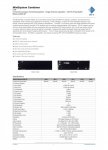Hello, this is my first post here and indeed my first time to ask a question concerning DMR with which I am very much a newbie.
As a part of a large construction project a client has installed two Kenwood THR-D810-E repeaters for use with some 30 or so Kenwood TK-D340 handhelds for security personnel. They have been allocated 2 frequency pairs and have configured the repeaters to transmit on the higher two frequencies and receive on the lower two frequencies. This is as per the combiner which is tuned appropriately. Handhelds have been programmed in the reverse.
Both repeaters are programmed with channel 1 in timeslot 1 and channel 2 in time slot 2, both are color code 1
Handhelds are programmed with 4 channels, the first two being timeslot 1 and 2 of the first repeater frequency and channels 3 and 4 programmed with the second repeaters timeslot 1 and 2.
For any selected channel keying one handheld results in hearing the signal repeated on the other handheld but with a constant regular chopping as if there is some sort of synchronisation problem.
I am not that familiar with DMR setup so if someone could point to an obvious mistake I would be very grateful. If anyone would be willing to guide me in a step by step way to resolve the issue that would also be most welcome. I have the configuration files for the repeater and the handhelds if that would be useful information.
Many thanks
Martin
As a part of a large construction project a client has installed two Kenwood THR-D810-E repeaters for use with some 30 or so Kenwood TK-D340 handhelds for security personnel. They have been allocated 2 frequency pairs and have configured the repeaters to transmit on the higher two frequencies and receive on the lower two frequencies. This is as per the combiner which is tuned appropriately. Handhelds have been programmed in the reverse.
Both repeaters are programmed with channel 1 in timeslot 1 and channel 2 in time slot 2, both are color code 1
Handhelds are programmed with 4 channels, the first two being timeslot 1 and 2 of the first repeater frequency and channels 3 and 4 programmed with the second repeaters timeslot 1 and 2.
For any selected channel keying one handheld results in hearing the signal repeated on the other handheld but with a constant regular chopping as if there is some sort of synchronisation problem.
I am not that familiar with DMR setup so if someone could point to an obvious mistake I would be very grateful. If anyone would be willing to guide me in a step by step way to resolve the issue that would also be most welcome. I have the configuration files for the repeater and the handhelds if that would be useful information.
Many thanks
Martin





